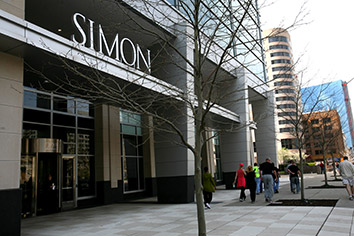Subscriber Benefit
As a subscriber you can listen to articles at work, in the car, or while you work out. Subscribe Now
 When Simon Property Group Inc. two years ago announced plans to spin off its less glitzy, less profitable malls, executives said they’d given the properties short shrift as they focused on large acquisitions and redevelopment projects.
When Simon Property Group Inc. two years ago announced plans to spin off its less glitzy, less profitable malls, executives said they’d given the properties short shrift as they focused on large acquisitions and redevelopment projects.
“The fact of the matter is, there have been a number of opportunities that the team has wanted to pursue that we put at the bottom of the list because we were focused on outlet growth or major redevelopment,” Simon CEO David Simon said at the time.
But some analysts saw an ulterior motive—a desire to cast off dicier properties before performance soured.
“Simon sees rough seas ahead for low-productivity, Class B regional malls—and rightly so!” UBS analyst Ross Nussbaum wrote at the time. Some of those malls “suffer from what we call the ‘fifth mall in a four-mall-town syndrome.’”
That fear proved well-founded, as the mall industry bifurcates into a world of haves and have-nots. Simon specializes in the former—upscale properties with the best tenants and entertainment options. The latter, so-called B and C malls, are losing out as retailers—many of them struggling—decide they need fewer brick-and-mortar locations to serve customers in the internet age.
The California-based retail real estate research firm Green Street Advisors said in a report that the top 3.5 percent of U.S. malls account for 22 percent of total U.S. mall value. On the other end of the spectrum, C malls make up 27.5 percent of all malls but account for just 4 percent of value.
And those divisions could get even more pronounced, as retailers further pare locations to boost performance. Specialty chains announcing closings in recent months include Finish Line, Aeropostale, Abercrombie & Fitch and PacSun. In addition, some of the nation’s best-known department store chains are foundering, and analysts expect several to retrench. A report this spring from Green Street said J.C. Penney would need to close 320 stores, Sears would have to close 300, and Macy’s would have to close 70 to return sales per square foot to 2006 levels.
 Sokolov
SokolovFor their part, retail real estate executives cast the concerns as overblown. In fact, Simon and Kite Realty Group Trust—Indianapolis’ publicly traded retail developers—say they are doing well and have a bright outlook.
“Our portfolio has never been stronger, and we still have significant demand for our properties,” Simon President Richard Sokolov said on an April 26 conference call.
On a conference call two days later, Kite CEO John Kite said new retail development had slowed to a trickle, which gives the company leverage to lure in new tenants at higher rents when retailers shutter stores.
 Kite
Kite“The reality is, this is nothing new,” said Kite, whose company specializes in open-air shopping centers. “This is the retail business. There will always be closings. That’s something we have always dealt with. And it just so happens that, in today’s supply-demand market we’re in, these closings generally work out to be opportunities.”
But the leverage is greater when demand is higher—as is the case with properties like the Fashion Mall at Keystone. Simon revealed last year the mall had eye-popping sales per square foot of $818, which puts it in the A+ range under Green Street’s grading scale.
Simon’s high-end focus has helped keep investors interested in the stock, despite the avalanche of negative headlines nationally about troubles among brick-and-mortar retailers. Simon shares are fetching $194—up from $171 a year ago, though down from their high earlier this month of nearly $215.
To no surprise, it’s been a rougher road for the Simon spinoff, which was known as Washington Prime Group before it acquired Glimcher Realty Trust last year and took on the moniker WP Glimcher Inc.
Shares in the company—now based in Columbus, Ohio—debuted in May 2014 at around $20 apiece. They’ve declined steadily and now fetch less than $10. The drop reflects investor sentiment that, “When retailers decide to close stores, lower quality malls will be most impacted,” Goldman Sachs said in a report.•
Please enable JavaScript to view this content.

